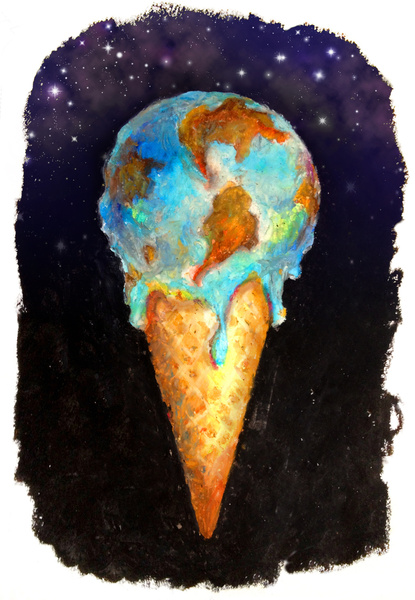Breezy and way-wet this early-evening Monday on California’s north coast — made an attempt to take the dogs for a walk/run this afternoon, first try at Little River Beach, and after sitting there in the car for awhile waiting for some respite, then when none came, a drive south to the Ma-le’l Dunes, where we discovered there’s no outrunning the rain. Cowboy looked especially grief stricken.
Dry maybe for a time tomorrow, as according to the NWS, ‘Chance Showers then Partly Sunny and Breezy‘ for Tuesday, then even better for Wednesday: ‘Mostly Sunny then Sunny and Breezy,’ so there’s that. And of course, rain back on Thursday.
Weather is a vital part of life nowadays. Although I’m whining about a little rain shower, the rest of the country is going some real-rough shit — across the south tornadoes and rainstorms, in the mid-west more rain and flooding, meanwhile in Denver: ‘“Highs will climb toward 80° on Tuesday but don’t put your winter coat away just yet! A strong cold front will decrease highs by 30° on Wednesday with rain changing over to snow by Wednesday night,” the National Weather Service said in a tweet Sunday.’
Whiplash weather it be…
And once again, another climate-change study — via InsideClimate News this afternoon:
Global warming is transforming the Arctic, and the changes have rippled so widely that the entire biophysical system is shifting toward an “unprecedented state,” an international team of researchers concludes in a new analysis of nearly 50 years of temperature readings and changes across the ecosystems.
Arctic forests are turning into bogs as permafrost melts beneath their roots.
The icy surface that reflects the sun’s radiation back into space is darkening and sea ice cover is declining.
Warmth and moisture trapped by greenhouse gases are pumping up the water cycle, swelling rivers that carry more sediment and nutrients to the sea, which can change ocean chemistry and affect the coastal marine food chain.
And those are just a few of the changes.
The researchers describe how warming in the Arctic, which is heating up 2.4 times faster than the Northern Hemisphere average, is triggering a cascade of changes in everything from when plants flower to where fish and other animal populations can be found.
Together, the changes documented in the study suggest the effects on the region are more profound than previously understood.
Most-likely to me, the recent often-used phrase, or words to the effect that’s really, really terrifying about climate change: ‘more profound that previously understood.’ which has become the mantra for environmental research. We’re more fucked than we first figured.
Further on that Arctic-warming study from Gizmodo:
Luckily, said Menard (Nome Area Management Biologist James Menard), the blow was offset by a good salmon season the last few years.
However, the loss of Bering sea ice could threaten other fisheries too, particularly if it impacts spring blooms of algae that grow on the ice and in the water column and form the base of the food chain.
That’s not all.
Throughout parts of the Bering sea, particularly St. Lawrence Island, climate change seems to be helping drive the replacement of shellfish like bivalves and snails with marine worms.
And blooms of toxin-producing algae, which can poison shellfish, are posing a mounting risk for the health of both humans and wildlife, Alaska Department of Fish and Game biologist Lori Quakenbush told Earther.
These blooms have already been associated with some wildlife die-offs.
This also marks the third year in a row that Alaska has seen massive, mysterious seabird die-offs. The common cause seems to be starvation—which may have been caused by toxic algae, or simply through shifts in Bering biodiversity.
Luckily, said Menard, the blow was offset by a good salmon season the last few years.
However, the loss of Bering sea ice could threaten other fisheries too, particularly if it impacts spring blooms of algae that grow on the ice and in the water column and form the base of the food chain.
That’s not all.
Throughout parts of the Bering sea, particularly St. Lawrence Island, climate change seems to be helping drive the replacement of shellfish like bivalves and snails with marine worms.
And blooms of toxin-producing algae, which can poison shellfish, are posing a mounting risk for the health of both humans and wildlife, Alaska Department of Fish and Game biologist Lori Quakenbush told Earther.
These blooms have already been associated with some wildlife die-offs.
This also marks the third year in a row that Alaska has seen massive, mysterious seabird die-offs. The common cause seems to be starvation—which may have been caused by toxic algae, or simply through shifts in Bering biodiversity.
And way-of-course, another study, this one published last week, reported carbon dioxide has reached levels in our atmosphere not seen for 3 million years — as you know, CO2 the biggest influence to global warming.
Matteo Willeit of the Potsdam Institute for Climate Impact Research in Germany, lead author in the research:
“It seems we’re now pushing our home planet beyond any climatic conditions experienced during the entire current geological period, the Quaternary.
“A period that started almost 3 million years ago and saw human civilization beginning only 11,000 years ago.
“So, the modern climate change we see is big, really big; even by standards of Earth history.”
So in the sense of the late-great George Carlin: ‘“…so I wouldn’t sweat the thundershowers.”‘
 (Illustration found here).
(Illustration found here).